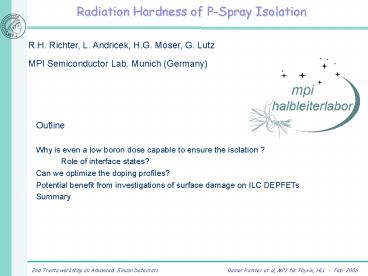Radiation Hardness of PSpray Isolation PowerPoint PPT Presentation
1 / 14
Title: Radiation Hardness of PSpray Isolation
1
Radiation Hardness of P-Spray Isolation
R.H. Richter, L. Andricek, H.G. Moser, G.
Lutz MPI Semiconductor Lab. Munich (Germany)
- Outline
- Why is even a low boron dose capable to ensure
the isolation ? - Role of interface states?
- Can we optimize the doping profiles?
- Potential benefit from investigations of surface
damage on ILC DEPFETs - Summary
2
Isolation capability
Still open questions from the point of view of
device physics Saturation value of fixed oxide
charge 2 x 1012 3.5 x 1012cm-2 in the same
range or even higher than the P-Spray boron dose
ca. 3 x 1012 cm-2 (Trade off between
breakdown voltage and isolation) Breakdown of
the isolation capability was never observed! Even
in the regions with reduced doping levels
(moderated p-spray)
3
Moderated P-Spray improves pre irradiation yield
4
Special test structures
P-bulk MOS capacitor
N-channel MOS transistor
Measurement (pre and after irradiation) of
band bending
VTH gt head room of isolation capability
estimation of implanted dose Subthreshold
characteristics Most relevant test structure for
isolation capability
5
Change of NMOS Transistor IV due to interface
statesP-Spray moderated region - boron dose
ca. 2 x 1012 cm-2 Jens Wüstenfeld (PhD Thesis
2001)
20 keV electron irradiation
unirradiated
5 kGy
560 kGy
How much head room (fixed oxide charges)?
Depends on the tolerable interpixel current1nA
Relevant gate voltage is 0V gt 20V safety margin
, NOX ? 2 x 1012 cm-2
6
Interpixel resistancePixel size 50 x 400µm²
Moderated P-Spray device after 560kGy
Interpixel voltage
7
Radiation induced interface states
- Microscopic structure PB0 and PB1 centres
(identified by Lenahan and Dressendorfer
with ESR) - Si atom back bonded to the Si lattice with three
orbitals - the fourth one is a dangling bond extending into
the oxide (111 silicon) - Creation Two stage model (McLean)
- 1) generated holes interact with the oxide
lattice - produce H ion
- 2) H drifts toward the interface (field
dependency) - arriving the interface it breaks a Si-H bond
to form H2 and - a dangling Si-bond
- (only possible when a positive electric
field is applied) - Electrical properties
- Amphoteric behaviour
- acceptors above midgap
- neutral at midgap
- donors below midgap
8
Discussions and conclusions
- At the n-side interface states a negative space
charge builds up if the fermi level is shifted
through the bandgap at the interface. - Possible consequences
- Movement of the critical high field region from
n to pspray during irradiation doesnt take
place. - The acceptor dose in the moderated region could
be reduced further. - May be this is even necessary if the interface
state density reaches very high levels. - Tasks
- Does the generation of interface states
saturates ? (contradictional statements in the
literature) - If yes at which level? For which bias
conditions? - We need samples for all radiation levels.
Especially, the low dose range have to be scanned
carefully! - My impression A comprehensive model which is
valid for all bias conditions and all oxides
(processing conditions) does not exist ! - nMOS Transistors with high and low pspray doping
are implemented in the RD50 mask set. - Looking for other pieces in the puzzle !
- DEPFET Development for ILC
9
(No Transcript)
10
Irradiated Devices - Overview
PXD4-2 L 6 µm A2-11, B2-11, D2-12 L 7
µm A2-21, B2-21, D2-22 PXD4-2 L10 µm
T10-11 L20 µm T20-11 PXD4-1 L60 µm
T60-13, T60-23, T60-33 PXD4-3 L5 µm
T5-11-2
D1
G1
Cl
S
Cl
G2
D2
Bias during irradiaton 1 empty int. gate, in
off state, VGS 5V, VDrain-5V ? Eox
0 2 empty int. gate, in on state, VGS-5V,
VDrain-5V ? Eox -250kV/cm 3
all terminals at 0V
NB only one row active at a time in normal
matrix operation! for a 512x1024
matrix ? Toff/Ton 1000!
- ? measure threshold voltage (quadratic
extrapolation if ID(VG) to ID0) as a function
of TID - all measurements with Vbulk10V..12V,
Vcleargate5V .. 12V ? empty internal Gate
11
Threshold voltage shift
- GSF National Research Center for Environment
and Health, Munich - 60Co (1.17 MeV and 1.33 MeV)
CaliFa Teststand at MPI HLL X-Ray tube with Mo
target at 30kV bremsstrahlung with peak at 17.44
keV
24 h annealing after each irradiation period ?
2 weeks irradiation
No annealing during irradiation ? 3 days
irradiation
-?Vth (V)
?Not (cm-2)
Dose (krad)
Dosimetry
Ionization Chamber, provided and calibrated by
GSF staff (W. Panzer, GSF) Dose rate 20
krad(SiO2)/h
Integrated Spectrum with known absorption coeff.
of SiO2 (A. Pahlke, HLL) Dose rate 9
krad(SiO2)/h
12
Basic Characteristics - pre and post-irradiation
VG-6V
VG-10V
ID (µA)
ID (µA)
VG-9V
VG-4V
VG-8V
VG-2V
VG-7V
-VD (V)
-VD (V)
13
Subtreshold slope ? interface traps
300 krad ? Nit21011 cm-2 912 krad ? Nit71011
cm-2
Literature After 1Mrad 200 nm (SiO2) Nit
1013 cm-2
14
Performance after irradiation
- Irradiated double pixel DEPFET
- L7µm, W25 µm
- after 913 krad, 60Co
- Vthresh-4V, Vgate-5.3V
- Idrain21 µA
- Drain current read out
- time cont. shaping ?6 µs
55Fe
Counts/channel
Noise ENC7.9 e- (rms) at Tgt23 degC
Energy (eV)

